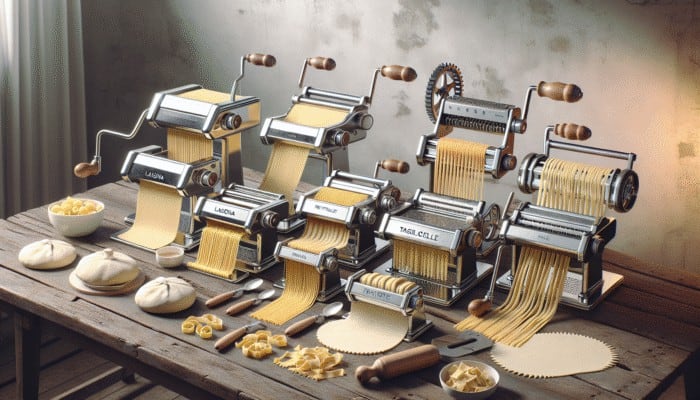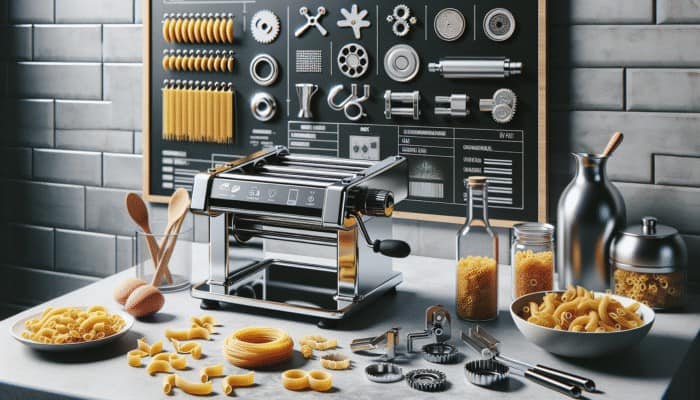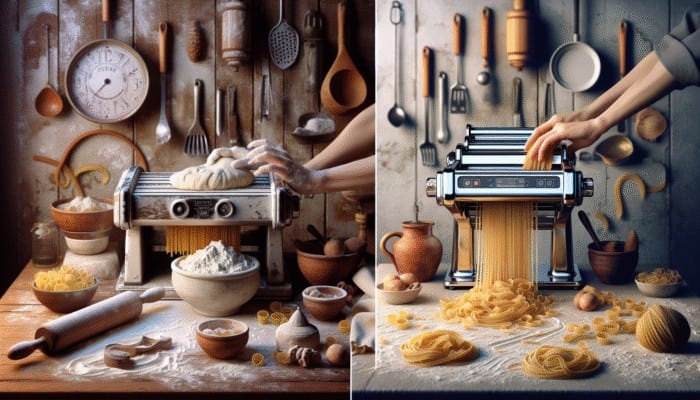Discover the Best Manual Pasta Machines for Crafting Authentic Homemade Pasta
Explore the Different Types of Manual Pasta Machines

Best Tools for Making Homemade Pasta: Manual pasta machines are highly regarded for their straightforward operation and effectiveness. They enable enthusiastic cooks to convert dough into fresh pasta with minimal effort. These machines are available in various styles and cater to a diverse range of culinary needs and preferences. The most prevalent variety is the hand-cranked pasta machine, equipped with adjustable rollers that create sheets of dough suitable for various pasta shapes. Depending on the attachments included, these versatile machines can produce multiple pasta types, such as lasagna, fettuccine, and tagliatelle. More sophisticated models may offer multiple attachments for crafting ravioli, spaghetti, or even unique specialty shapes, expanding your culinary repertoire.
Artisan pasta makers can be discovered in workshops worldwide, each showcasing local culinary traditions. For example, artisanal pasta machines in Italy often exemplify generations of craftsmanship, merging functionality with aesthetic beauty. Whether you seek a basic machine or a more intricate setup, exploring the market and familiarising yourself with the various types will empower you to decide on the best tools for making homemade pasta.
Uncover the Benefits of Using Manual Pasta Machines
Opting for a manual pasta machine presents a distinctive, hands-on experience many cooking enthusiasts hold dear. One of the key advantages is the level of control it offers over the thickness and texture of your pasta. Adjusting the rollers allows you to create a spectrum of pasta thicknesses, ensuring your culinary creations align with your personal taste preferences. Moreover, manual machines generally exhibit greater durability compared to their electric counterparts. They are often constructed from robust materials like stainless steel or heavy-duty plastic, which ensures longevity with appropriate maintenance.
The tactile process of rolling out dough can also induce a meditative state, connecting you to the ancient tradition of pasta-making. For numerous individuals, making pasta by hand evokes fond memories of family gatherings and a rich culinary heritage. This connection to age-old practices enhances the cooking experience and results in pasta that frequently boasts a superior taste, fresh and homemade, delivering a delightful flavour that mass-produced options simply cannot rival.
Essential Maintenance and Care Tips for Your Pasta Machine
Several maintenance practices are crucial to keeping your manual pasta machine in pristine condition. Start by routinely wiping down the exterior with a damp cloth to eliminate any flour residue that may accumulate. Avoid submerging the machine in water, as this could potentially damage sensitive components. After each use, inspect the rollers for any dough remnants and carefully remove them using a brush or a dry cloth to maintain optimal functionality.
Additionally, it's advisable to periodically lubricate the moving parts with food-safe oil to ensure the mechanism operates smoothly. Store your machine in a dry location, ideally in its original box or a dedicated storage area, shielded from humidity and extreme temperatures. Adhering to these maintenance tips will extend the lifespan of your machine, solidifying its reputation as one of the best tools for making homemade pasta for many years to come.
How to Select the Perfect Manual Pasta Machine for Your Needs

Choosing the ideal manual pasta machine involves evaluating several factors that align with your cooking style and personal preferences. Size is crucial; if counter space is limited, a compact model may suit you best. However, larger machines producing wider pasta sheets may benefit those who frequently entertain or prepare substantial quantities of food.
Material is another important aspect to consider. Stainless steel is often the material of choice for its durability and ease of cleaning. Furthermore, contemplate the types of pasta you aspire to create. If you intend to make various shapes, seek machines with multiple attachments. Lastly, perusing reviews and user experiences can provide valuable insights into the performance and reliability of various models, steering you toward the best tools for making homemade pasta that align with your culinary ambitions.
Electric Pasta Makers: Your Go-To Tools for Effortless Homemade Pasta
Discover the Key Features of Electric Pasta Makers
Electric pasta makers revolutionise the pasta-making experience, especially for those who appreciate the convenience that technology brings to the kitchen. Designed for speed and efficiency, these machines automate the pasta-making process, allowing you to create fresh pasta with minimal effort. A standout feature is the ability to adjust the thickness of your dough at the touch of a button, making it simple to achieve the ideal consistency for various dishes.
Many electric models have various attachments, enabling you to produce various pasta types, from delicate angel hair to hearty pappardelle. The versatility offered by electric pasta makers attracts those looking to explore the depths of pasta-making without the physical exertion associated with manual machines. Additionally, their user-friendly design often draws in novice cooks who may feel daunted by traditional methods. For anyone eager to delve into global pasta recipes, having an electric maker can unlock many culinary possibilities, placing it among the best tools for making homemade pasta.
Comparing the Merits of Electric and Manual Pasta Makers

The discussion surrounding electric versus manual pasta makers often hinges on personal preference and lifestyle. Manual machines provide a traditional, hands-on experience that many purists cherish, allowing you to engage with the process and refine your skills fully. They tend to be more affordable and simpler to maintain, making them an excellent choice for beginners or those who relish the ritual of pasta making.
Conversely, electric pasta makers excel in convenience and speed, appealing to busy individuals or families prioritising efficiency. They can produce large quantities of pasta quickly, making them ideal for hosting dinner parties or meal prepping for the week ahead. However, the initial investment is typically higher, and some models can be cumbersome, presenting storage challenges. When deciding between the two, reflect on your cooking style, the types of dishes you wish to create, and the time you can allocate to the art of pasta making.
Cleaning and Storing Your Electric Pasta Maker: Best Practices
Proper cleanliness and storage of your electric pasta maker are crucial for ensuring its functionality and hygiene. Begin by unplugging the machine and allowing it to cool down before cleaning. Use a dry cloth or brush to remove any remnants of dough or flour, being cautious not to expose electronic components to water, as this can cause damage. A damp cloth may be used for persistent residue, but always ensure that the machine is entirely dry before storage.
When it comes to storing your pasta maker, select a cool, dry space that is easily accessible, as you are likely to use it frequently. If the machine includes a protective case or cover, utilise it to shield your investment from dust and moisture. Designating a specific spot in your kitchen for your best tools for making homemade pasta, including the electric maker, will encourage regular use and culinary experimentation.
The Essential Role of Pasta Rolling Pins in Homemade Pasta Creation
Why Traditional Pasta Rolling Pins are Indispensable
Traditional wooden rolling pins, renowned for their reliability and simplicity, have long been a cherished fixture in kitchens worldwide. Their substantial weight ensures even pressure across the dough, which is vital for achieving consistent thickness and an essential aspect of pasta making. The classic design, often crafted from hardwood, provides a natural, non-stick surface that enhances the rolling experience.
Many chefs advocate for the tactile feedback of a wooden rolling pin, as it allows for a more intuitive understanding of the pressure needed for perfect dough. Additionally, rolling pins come in various sizes and thicknesses, enabling you to select one that aligns best with your pasta-making needs. Whether preparing delicate lasagna sheets or robust fettuccine, a traditional rolling pin is a timeless tool that embodies the essence of crafting homemade pasta.
Innovative Modern Rolling Pin Designs
The evolution of kitchen tools has given rise to modern rolling pins featuring enhanced functionalities that simplify pasta-making. Many contemporary rolling pins are designed with adjustable thickness rings, allowing you to achieve uniform dough thickness effortlessly. This innovation removes the guesswork often associated with rolling out pasta, guaranteeing perfect results every time.
Furthermore, many modern rolling pins incorporate non-stick technology, such as silicone surfaces, which reduce the amount of flour needed and help to prevent dough from adhering. This feature is particularly beneficial when working with wetter dough types, facilitating a smoother rolling experience. As you explore your options, consider how these innovative features align with your cooking style and needs. The right rolling pin can significantly elevate your pasta-making journey, solidifying its status as one of the best tools for making homemade pasta.
Techniques for Mastering the Use of Rolling Pins
Mastering the art of using a rolling pin is essential for achieving the perfect pasta dough. Begin by ensuring your work surface is adequately floured to prevent sticking. When rolling out dough, apply consistent pressure and roll from the centre outward, rotating the dough a quarter turn after each pass. This technique promotes an even thickness and helps maintain a circular shape, crucial for uniform pasta pieces.
An additional effective technique involves using a gentle back-and-forth motion while rolling, allowing the dough to stretch without tearing. If you’re dealing with particularly thick dough, consider employing a two-step approach: flatten the dough slightly with your hands before introducing the rolling pin. This initial flattening can ease the rolling process and ensure the dough remains pliable. You'll develop a rhythm with practice and patience, transforming your rolling pin into one of your best tools for making homemade pasta.
Choosing the Ideal Rolling Pin for Your Specific Needs
Selecting the perfect rolling pin involves assessing your cooking style and the types of pasta you frequently create. Traditional wooden pins are ideal for those who appreciate a classic approach, while silicone or marble options may be advantageous if you often work with dough that tends to stick. Consider the pin's size as well; a longer rolling pin can provide a greater range of coverage, which is particularly beneficial for crafting large sheets of pasta.
Additionally, pay close attention to the weight of the rolling pin. Heavier pins can simplify the rolling process, as they naturally exert pressure without requiring much effort from the user. The right pair of scissors should feel comfortable, allowing you to manoeuvre them effortlessly while crafting your best tools for making homemade pasta.
Caring for Your Rolling Pin: Tips for Longevity
Proper care for your rolling pin ensures its longevity and performance. After each use, gently wipe it down with a damp cloth to remove any flour or dough remnants. Avoid soaking it in water, which can warp the wood or damage other materials. If your rolling pin is wooden, consider treating it periodically with food-safe mineral oil to keep the wood hydrated and prevent cracking.
Storage is equally important; place your rolling pin in a cool, dry area, ideally laying it flat or hanging it to avoid bending. If it includes a protective cover or sleeve, use it to keep dust and debris at bay. With proper maintenance, your rolling pin will remain one of your best tools for making homemade pasta, always ready for your next culinary adventure.
Pasta Cutters: Essential Tools for Crafting Perfect Homemade Pasta
Explore the Various Types of Pasta Cutters
Pasta cutters are available in many designs, each serving a unique purpose for pasta-making. Hand-held cutters are particularly popular due to their simplicity and ease of use. They provide an efficient way to slice fresh pasta sheets into your desired shapes. These cutters often come in various widths, allowing you to create everything from tagliatelle to fettuccine with precision.
Rotary cutters present a highly efficient solution for those seeking more advanced options. These devices typically feature multiple blades, facilitating the simultaneous cutting of several pasta strands. This accelerates the process and guarantees consistent shapes and sizes, which is invaluable for anyone preparing large quantities of pasta. Having the right pasta cutter is essential for achieving the perfect finish on your homemade pasta creations, no matter what type you choose.
Selecting the Perfect Pasta Cutter for Your Culinary Needs
Choosing the right pasta cutter largely depends on the types of pasta you intend to make and your level of expertise. Beginner cooks may find hand-held cutters more manageable, offering greater control over the cutting process. Typically more affordable and easier to clean, these cutters represent a sensible choice for those embarking on their pasta-making journey.
In contrast, experienced chefs might appreciate the efficiency and speed of rotary cutters. These are ideal for larger batches or when time constraints are a factor. Additionally, consider the materials used; stainless steel cutters are often more durable and simpler to clean than their plastic counterparts. Ultimately, the best pasta cutter will complement your cooking style, enhancing your capability to create authentic dishes from around the globe.
Safety Guidelines for Using Pasta Cutters
Safety should always be paramount when using pasta cutters, particularly those with sharp blades. Always handle your cutters carefully, utilising a firm grip and cutting away from your body to minimise the risk of accidents. Store your cutters in a protective sheath or case to keep blades safe and maintain their sharpness when not in use.
If you’re utilising a rotary cutter, ensure the machine is stable and the blades are securely attached before operation. Regularly inspect for any signs of wear and tear, replacing blades as necessary to provide a clean cut. By adhering to these safety guidelines, you can enjoy the art of pasta making with peace of mind, knowing you’re using one of the best tools for making homemade pasta safely and effectively.
Maintaining Your Pasta Cutters for Optimal Performance
Proper maintenance of your pasta cutters is vital for keeping them in excellent condition. After each use, clean the blades with a soft brush or cloth to eliminate any leftover pasta or flour. Avoid soaking them in water, as this can lead to rust or damage, especially if they possess wooden handles.
A gentle scrub with mild soap and warm water is often sufficient for stainless steel cutters. Ensure they are thoroughly dried before storage to avoid moisture-related issues. Regularly inspect your cutters for any signs of dullness, and sharpen or replace blades as needed. With consistent care, your pasta cutters will remain effective, contributing to your collection of the best tools for making homemade pasta.
The Essential Role of Pasta Drying Racks in Pasta Preparation
Understanding the Importance of Pasta Drying Racks
Pasta drying racks are crucial to the pasta-making process, ensuring your freshly crafted pasta dries evenly while maintaining its shape. Properly drying pasta prevents it from sticking together, allowing for an improved texture once cooked. The drying process also enhances flavour, allowing the pasta to set, creating the ideal foundation for sauces and toppings.
A drying rack is especially vital for delicate pasta types such as egg noodles or filled pastas, as it facilitates adequate air circulation. This circulation prevents moisture from lingering, which can lead to spoilage. Investing in a quality pasta drying rack will elevate the quality of your pasta and streamline your overall cooking process, making it one of the best tools for making homemade pasta.
Explore the Different Styles of Pasta Drying Racks
Pasta drying racks come in various styles to suit different kitchen spaces and needs. Traditional wooden racks, often resembling a clothesline, allow multiple strands of pasta to hang freely, utilising gravity for even drying. These compact racks are ideal for small kitchens or areas with limited counter space.
Conversely, multi-tiered drying racks offer a vertical solution that maximises space. These racks can accommodate a significant amount of pasta while keeping it separated, minimising the risk of sticking. Some modern racks even collapse for convenient storage, making them an excellent choice for those with restricted kitchen real estate. Regardless of your style, having a designated drying rack enhances efficiency in your pasta-making routine.
Maximising the Effectiveness of Your Pasta Drying Rack
To effectively utilise your pasta drying rack, ensure the pasta is spread evenly without overcrowding. This practice allows for proper air circulation, critical for achieving the desired texture. If you're working with particularly long strands, ensure they are well-floured to prevent them from sticking together during drying.
Timing is also essential; allow your pasta to dry sufficiently before cooking. A typical drying time of 30 minutes to an hour is recommended, although this can vary based on humidity levels and the type of pasta. If you reside in a particularly humid area, consider using a fan to enhance airflow around the drying rack. By implementing these tips, you’ll optimise the performance of your drying rack, further solidifying its status as one of the best tools for making homemade pasta.
Maintenance and Cleaning Guidelines for Pasta Drying Racks
Caring for your pasta drying rack is a simple yet essential task that ensures longevity. After each use, shake off any flour or pasta remnants and clean the surface thoroughly. If your rack is crafted from wood, a gentle wipe with a damp cloth will suffice; however, avoid soaking it to prevent warping.
A quick wash with warm, soapy water for metal or plastic racks will help maintain cleanliness. Ensure all components are completely dry before storing to prevent mould and mildew. Regular maintenance assures hygiene and keeps your drying rack functional and visually appealing, making it one of your best tools for making homemade pasta for years to come.
The Vital Role of Pasta Measuring Tools in Homemade Pasta Preparation
Why Accurate Measurements Matter in Pasta Making
Accurate measurements are critical in pasta making, as they significantly influence the final product's texture and taste. Unlike other culinary pursuits, pasta relies heavily on precise ratios of flour to water, where even minor deviations can lead to considerable differences in the finished dish. This precision is especially important when considering different types of flour, as each has unique absorption properties that affect dough consistency.
For novices, the right measurements can eliminate guesswork, establishing a solid foundation for experimentation. As you refine your skills, grasping the importance of accurate measurements allows for greater recipe creativity and ensures consistent results. This precision ultimately elevates your homemade pasta to a restaurant-quality level, positioning the right measuring tools among the best for making homemade pasta.
Explore the Various Types of Pasta Measuring Tools
A range of measuring tools is available to facilitate precise pasta preparation. Classic measuring cups and spoons serve as reliable starting points, enabling you to portion flour and water accurately. However, for those serious about their pasta-making endeavours, investing in a digital scale is highly advisable. Scales provide the most accurate measurements, particularly for recipes that require specific weight ratios rather than volume.
Some chefs also prefer measuring devices designed explicitly for pasta, which may include measuring tools for measuring pasta portions that help ensure each serving remains consistent. These tools simplify the process, especially when preparing dishes for gatherings or meal prepping. Ultimately, the right measuring tools can significantly enhance your pasta-making experience, placing them among the best tools for making homemade pasta.
Mastering Techniques for Accurate Measurements
The proper techniques for measuring ingredients can greatly influence the success of your pasta creations. Always ensure your measuring cups are level when scooping flour; this helps to prevent overpacking, which can lead to excessive flour ratios. For liquid ingredients like water or eggs, measuring cups with clear markings allow for precise additions.
When using a digital scale, it's beneficial to zero out the weight of the bowl or container before adding your ingredients. This ensures you're measuring solely the contents without the added weight of the container. Additionally, consider the temperature of your ingredients; for instance, room temperature eggs blend into dough more effectively than cold ones. By honing your measurement techniques, you will develop a more consistent and enjoyable pasta-making practice, reinforcing the significance of precise tools in your kitchen.
Maintaining Your Measuring Tools for Longevity and Accuracy
Caring for your measuring tools is essential to maintaining their reliability and accuracy. Traditional cups and spoons can be kept in good condition by a gentle wash with warm, soapy water. Avoid abrasive cleaners that may scratch or damage the surface. Digital scales should be wiped down with a damp cloth and stored in a dry location to prevent damage to the battery or electronic components.
If you utilise specific pasta measuring devices, consult the manufacturer’s recommendations for cleaning and care. Regular maintenance ensures that your measuring tools remain among the best for making homemade pasta, equipping you with the reliability needed for perfect dishes every time.
Frequently Asked Questions About Pasta-Making Tools
What is the best material for a manual pasta machine?
Stainless steel is the most recommended material for manual pasta machines due to its durability, ease of cleaning, and rust resistance, making it a long-lasting investment.
Can I use a regular rolling pin to make pasta?
Yes, a regular rolling pin can be used for pasta; however, a dedicated pasta rolling pin may provide superior results, particularly in terms of thickness and control.
How long should I let my pasta dry?
Pasta should ideally dry for 30 minutes to an hour before cooking, although this duration may vary based on humidity and the type of pasta.
Do I need to flour my pasta-cutting tools?
Flouring your pasta-cutting tools is essential to prevent sticking and ensure clean cuts, especially when working with fresh dough.
Is an electric pasta maker worth the investment?
An electric pasta maker can be worthwhile for individuals who frequently make pasta and value convenience, speed, and consistent results without the physical effort required by manual machines.
How do I store homemade pasta?
Homemade pasta should be stored in an airtight container in the fridge for short-term use or dried and kept in a cool, dry place for longer storage.
What is the best way to clean pasta cutters?
Clean pasta cutters with a soft brush or cloth to remove dough and flour, avoiding soaking them in water to prevent damage and rust.
Can I make gluten-free pasta with these tools?
Yes, most tools can be used to create gluten-free pasta; however, ensure you have the appropriate recipes and adjust measurements for the best results.
What should I look for in a pasta drying rack?
Look for a drying rack that is sturdy, easy to store, and promotes adequate air circulation to prevent sticking and ensure your pasta dries evenly.
Are there any alternatives to a pasta machine?
Yes, pasta can be made without a machine using a rolling pin and knife, although this method may require more effort to achieve consistent thickness.



Your exploration of manual pasta machines really highlights the charm and practicality of making pasta from scratch. There’s something fundamentally rewarding about the entire process—from kneading the dough, adjusting the rollers, to finally shaping the pasta. The tactile experience alone sets it apart from store-bought options, and each step seems to cultivate a deeper appreciation for this culinary art.
It’s fascinating to delve into the world of manual pasta machines, isn’t it? The artistry behind crafting authentic homemade pasta seems to blend tradition with creativity, providing an avenue for both culinary expression and cultural connection. I love how you highlighted the various types of pasta machines and their unique capabilities. For many, the hand-cranked model represents not just a tool, but an experience—one that reconnects us to the hands-on nature of cooking that can sometimes feel lost in our modern, technology-driven kitchens.
I appreciate the exploration of manual pasta machines and their varying capabilities. It’s fascinating how these simple yet effective tools can connect us to traditional culinary practices. I recently started experimenting with a hand-cranked machine myself, and I found it surprisingly meditative. There’s something incredibly satisfying about the tactile experience of kneading the dough and watching it transform into delicate sheets of pasta.